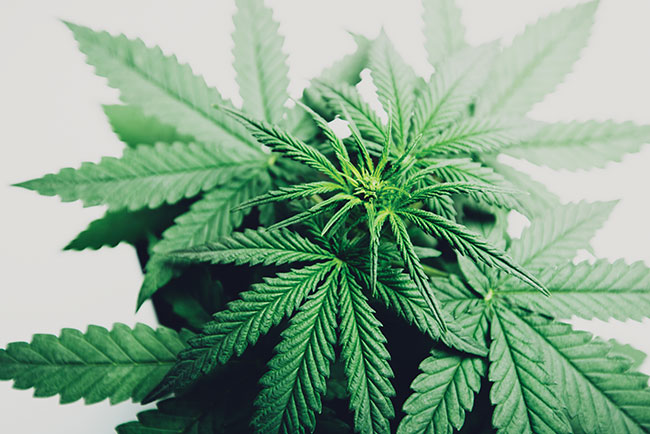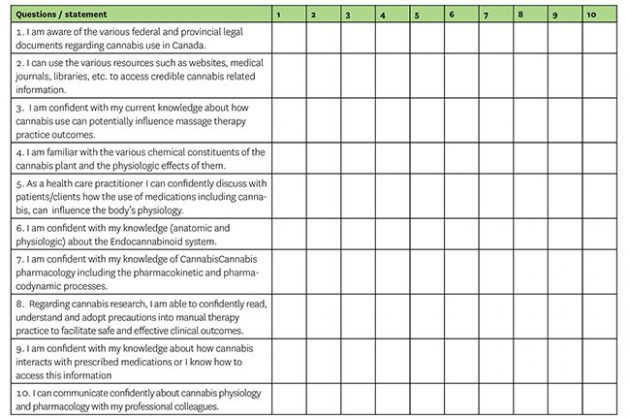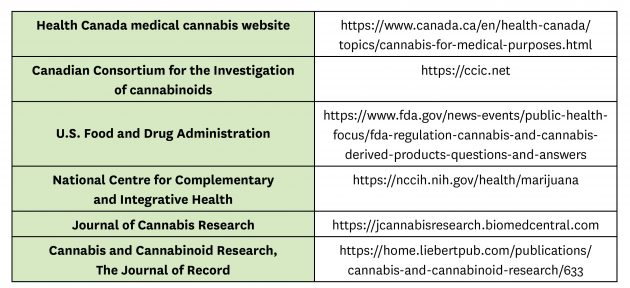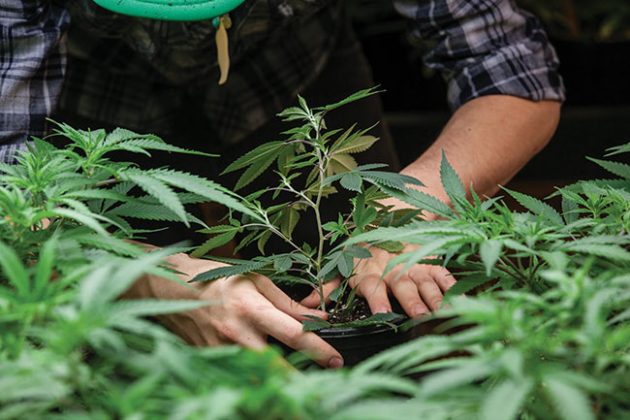
Features
Wellness
Education
Patient Care
Practice
Cultivating cannabis awareness: Considerations for the massage therapy profession
October 9, 2020 By Randy Persad
 Photo: Yarygin / iStock / Getty Images Plus / Getty Images
Photo: Yarygin / iStock / Getty Images Plus / Getty Images Why is it important for manual therapy practitioners to know if their patients/clients are using cannabis and what is the relevance of this information to manual therapy practice and to the profession? The short answer to these questions is: “Both cannabis and massage therapy influences physiology and an informed practitioner is most likely able to recognize when providing massage therapy service to a cannabis (or any other medication) use, prescribed or not, may be unsafe.”
Since legalization, an increasing number of patients/clients have disclosed to me they are using cannabis. Some for medical purposes on their doctor’s recommendation, and others for adult, non-medical use. For example, 80-year-old Victoria (not her real name) was excited to tell me how her niece made a cannabis plant extract/oil to apply to her sore shoulder, or Vernon (not his real name) who has hypertension and a degenerative central nervous system condition, explained how he started smoking a new cannabis strain that brings longer-lasting pain relief, allowing him a few more hours of much needed sleep.
With this backdrop, let’s look at how the massage therapy profession can ensure its members have the basic awareness and understanding of cannabis physiology and pharmacology. There are two possible pathways:
- Incorporate appropriate cannabis educational skills, knowledge and attitudes in massage therapy programs and,
- Provide licensed practitioners with opportunities to deepen their curiosity and knowledge around the physiology and pharmacologic effects of cannabis
A general point of entry might be assessing your current level of knowledge. The table below provides a few questions for developing a baseline assessment of your cannabis knowledge.
Having completed this basic assessment of your cannabis knowledge, what’s next? Begin by familiarizing yourself with credible sources.

Please take a few moments and complete the following questions related to your general knowledge of this subject. Rate your answer on a scale between 1-10, where 1 represents none or very little knowledge/interest/ability etc. and 10 represents high level knowledge /interest/ability etc.
Massage therapy program design
Massage therapy (MT) programs usually include a course on medication/pharmacology awareness in their curriculum. At the core of this course is unpacking the language of pharmacology so practitioners can confidently read and extract relevant information regarding a drug and then determine what massage therapy precautions are necessary (if any) to ensure a safe and effective treatment outcome. Learners are introduced to the very basics of pharmacology including the pharmacokinetics and pharmacodynamics of various groups of commonly used medications. It is well established that the concurrent use of a drug/medication can influence assessment, treatment, and selfcare recommendations. MT programs should now consider including the following performance objectives in the curriculum:
Performance objectives
- Describe the emergence of cannabis in society
- Define and describe the anatomy and physiology of the endocannabinoid system
- Define and describe disorders of the endocannabinoid system
- Describe the general chemical constituents of the cannabis plant
- Define and describe the routes of administration of cannabis
- Define and describe the general pharmacology of cannabis
- Be able to undertake a cannabis literature search and interpret the research as it relates to massage therapy practice, and be able to plan a treatment to ensure a safe and effective outcome
- Practice professionally regardless of personal beliefs.
These performance objectives can be further unpacked into specific learning objectives with the accompanying assessment vehicles, much like what’s outlined in the current Inter-Jurisdictional Practice Competencies and Performance Indicators for Massage Therapists at Entry-to-Practice (Federation of Massage Therapy Regulatory Authorities of Canada, 2016). While on the surface this might look like a daunting task (and perhaps it might be), these objectives can be included in various already established courses. For example, in a professional development class students can be challenged to reflect on the factors that have influenced their beliefs around cannabis use and how these beliefs can influence their abilities (for example the ability to suspend judgement) to authentically provide manual therapy to an individual who is using cannabis. Or, perhaps they can attempt to formulate a response if a client discloses to them they were using cannabis. The anatomy and physiology of the endocannabinoid system can be a general part of the anatomy and physiology courses, while a cannabis literature search on the medicinal benefits of cannabis can take the form of an assignment in the research course. By implementing the above suggestions, MT school owners, administrators and faculty will have to forge new relationships with stakeholders who can provide the assistance in developing, delivering, assessing and evaluating this new aspect of the curriculum.
Cannabis awareness for the licensed/registered massage therapist
At the start of this article I shared two examples of patients/clients disclosing the use of cannabis. What might the follow-up dialogue be? Perhaps it might go like this:
Victoria: Randy, my niece made a cannabis oil for my sore shoulder.
Randy: That’s thoughtful of her. When did you started using it?
Victoria: I started about two weeks ago, I rub it on about three times per day.
Randy: Show me where you apply it. Did it relieve your shoulder pain?
Victoria: Oh yes, it was especially good to apply before bedtime, it took the edge off the pain and I was able to get some sleep.
Randy:Did you use it on the shoulder today?
Victoria: Yes I applied it on about four hours ago.
And so on….
The overall objective is to understand what relationship Victoria has with cannabis. In this case, the topical cannabis oil application relieved the shoulder pain allowing for a healthy sleep pattern. Victoria demonstrates a healthy, perhaps curious relationship with cannabis. As with any other topical pain remedy, practitioners need to apply various precautions when treating and when recommending rehabilitation activities. There might be compromised patient feedback regarding manual techniques and hydrotherapy applications, inaccurate special tests (selective tissue tension tests) results, and activities such as stretching and strengthening activities may need modification.
With general topical applications of cannabis such as in this example (a home-made product), the effects would most likely be localized. While it’s expected there will be very minimal, if any, systemic absorption, given that Victoria is in her 80s, it would be important to check the integrity of the skin, know how large the area of application is, and what carrier oil is used. These factors may impact the systemic absorption of the cannabis oil at the site of application.
On this note, we must draw attention to research that points to the use of a topical transdermal preparation of cannabidiol (CBD) when treating joint inflammation. In this research, an inflammatory response was invoked in rats that were subsequently treated with transdermal CBD application. The data analysis and general conclusion from the authors suggest the preparation was indeed absorbed through the skin and may have had both local and systemic effects to reduce the inflammation and cause positive changes in pain related behaviours. (Hammell & et.al, 2016). A transdermal preparation is a specifically designed preparation such as a skin patch embedded with the medical substance. (Note: not all skin patches are transdermal.) The patch delivers the medical substance through the skin and into the systemic circulation. With both transdermal and local applications, it is necessary to assess the appropriateness of treating and to be aware of the potential for compromised patient feedback over the area of application.
Vernon on the other hand disclosed smoking a new strain of cannabis. When smoked, cannabis enters the systemic circulation almost immediately, and the effects can last for several hours. A detailed history of Vernon’s smoking habits, his use of any other medications and his general executive functional abilities would be important points of inquiry. Vernon seems to exhibit a long-standing, attuned and perhaps dependent relationship with cannabis. The practitioner will have to monitor Vernon more carefully for systemically adverse reactions such as light-headedness and cardiovascular changes.
Knowing how to navigate the burgeoning cannabis information highway is a challenge on any given day, however there are a few immediate sources that can be accessed. The massage therapy regulatory agency or equivalent organizations are good starting points. The College of Massage Therapists of British Columbia and the College of Massage Therapists of Ontario have website statements regarding cannabis Legalization and Massage Therapy Practice (College of Massage Therapists of British Columbia, 2018, College of Massage Therapists of Ontario, 2018). Practitioners are encouraged to informed themselves of these postings. Likewise, other MT associations and regulatory bodies across Canada provides information for members so take a moment and check your provincial association or regulatory body’s website for more details.
Below is a list of government sites, medical journals and various organizations that can be a good starting point. Note that the resources provided are intended to get you started and they are by no means a complete list of resources.

To further deepen your knowledge of the medicinal/clinical research around cannabis there are two documents that every health care practitioner should have access to. These are:
• Information for Health Care Professionals: Cannabis (marihuana, marijuana) and the cannabinoids. This document can be downloaded from the Government of Canada website atcanada.ca/en/health-canada/services/drugs-medication/cannabis/information-medical-practitioners/information-health-care-professionals-cannabis-cannabinoids.html. Health Canada says this about the document: “This document is a summary of peer-reviewed literature and international reviews concerning potential therapeutic uses and harmful effects of cannabis and cannabinoids. It is not meant to be comprehensive and should be used as a complement to other reliable sources of information. This document should not be construed as expressing conclusions or opinions from Health Canada about the appropriate use of cannabis (marijuana) or cannabinoids for medical purposes.”
• Update of Cannabis and its medical use. This 2015 World Health Organization (WHO) document can be accessed at who.int/medicines/access/controlled-substances/6_2_cannabis_update.pdf. The document states “The evidence presented on potential medical uses and risks of cannabis in humans focuses on unprocessed, botanical cannabis and not isolated cannabinoids, some of which are medically approved. This is because it has been suggested that the cannabis plant contains chemicals that may be useful for treating illnesses or symptoms. Therefore, it has been advanced that whole plant cannabis could be used for medical purposes. The plant contains at least 750 chemicals, among which are some 104 different cannabinoids.”
Both of these documents are well researched, with contributions from respected clinicians and researchers from a wide range of disciplines.
Practitioners can also align themselves with various cannabis conferences and trade shows, and collaboration with your local licensed cannabis retail store can be an invaluable resource center for MT students and practitioners. The retail stores have very specific guidelines mandated by the federal government regarding operation, interaction with the public, and sale of products. They may be subjected to random inspections, so to encourage a positive introduction when you contact them, be clear about your purpose for the visit/appointment.
You can access a list of licensed retail stores throught the respective provincial cannabis retail licening websites. Below are three examples:
- In British columbia it’s https://justice.gov.bc.ca/cannabislicensing/ and
- In Alberta it’s https://aglc.ca/cannabis/retail-cannabis/cannabis-licensee-search
- In Manitoba it’s https://lgcamb.ca/cannabis/store-list/
Cultivating both intraprofessional and interprofessional relationships with “professional learning communities” can provided much needed support for practitioners. For example, provincial massage therapy associations can consider offering cannabis education courses either at specific times and locations or at their AGMs. Or, regulatory colleges (medical, nursing, physiotherapy) may have online continuing education courses on cannabis that may be appropriate for the RMT. Cannabis for health, medical and adult use may very soon be a global reality. RMTs are expected to stay current with the health care profession, and cannabis physiology and pharmacology is one area of study that the profession must embrace.

Photo: @ Eric Limon / Adobe Stock
References
- Brand, E. J., & Zhao, Z. (2017, March 10). Cannabis in Chinese Medicine: Are Some Traditional Indications Referenced in Ancient Literature Related to Cannabinoids? Frontiers in Pharmacology, 8(108). Retrieved February 5, 2018, from http://doi.org/10.3389/fphar.2017.00108
- College of Massage Therapists of British Columbia. (2018, October 12). Notices to the Profession – Legalization of Cannabis. Retrieved from College of Massage Therapists of British Columbia: https://www.cmtbc.ca/2018/10/12/legalization-of-cannabis/
- College of Massage Therapists of Ontario. (2018). Practice Resource: Cannabis. Retrieved from College of Massage Therapists of Ontario: https://www.cmto.com/whats-new/practice-resource-cannabis/
- Erkelens, J. L., & Hazekamp, A. (2014). That which we call Indica, by any other name would smell as sweet. Cannabinoids, 9(9), 9-15.
- Federation of Massage Therapy Regulatory Authorities of Canada. (2016, September). Inter-Jurisdictional Practice Competencies and Performance Indicators for Massage Therapists at Entry-to-Practice.
- Fleming, M., & Clarke, R. (1998). Physical evidence for the antiquity of Cannabis sativa L. Journal of the International Hemp Association, 80-92. .
- Hammell, D., & et.al. (2016, July). Transdermal cannabidiol reduces inflammation and pain-related behaviours in a rat model of arthritis. European Journal of Pain, 936-948.
- Map of Cannabis Retail Stores in B.C. (n.d.). Retrieved October 2019, from Cannabis Licensing: https://justice.gov.bc.ca/cannabislicensing/map
- Massage Therapists Association of Alberta. (2018). Cannabis Regulation. Retrieved from Massage Therapists Association of Alberta: https://www.mtaalberta.com/?page=361
- News Network Archaeology. (2014, March 2). 9,000-Year-Old Fabric Found At Çatalhöyük. Retrieved from News Network Archaeology: https://archaeologynewsnetwork.blogspot.ca/2014/02/9000-year-old-fabric-found-at-catalhoyuk.html#xUIb3j0qgEOIICj1.97
- Russo, E. B. (2007). History of Cannabis and Its Preparations in Saga, Science, and Sobriquet . CHEMISTRY & BIODIVERSITY – Vol. 4 (2007), 4, 1614-1648.
Randy Persad brings over 30 years of diverse experience in the health care profession. He is an Educational Consultant for Massage Therapy Programs, and has a clinical practice in Port Moody British Columbia.
Print this page